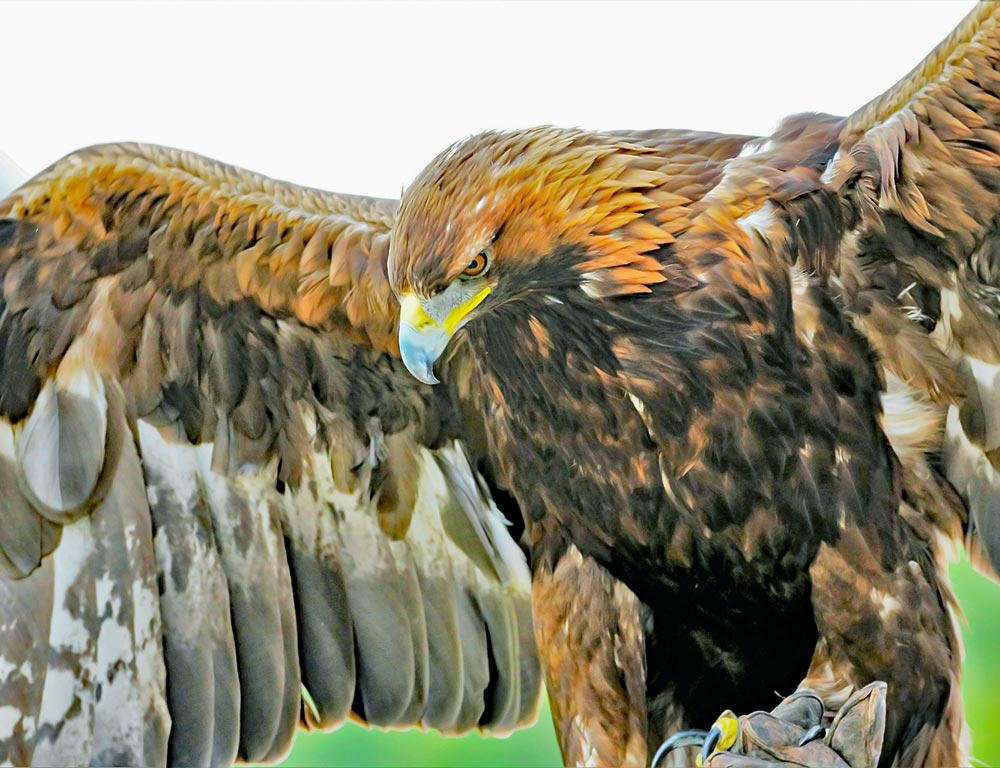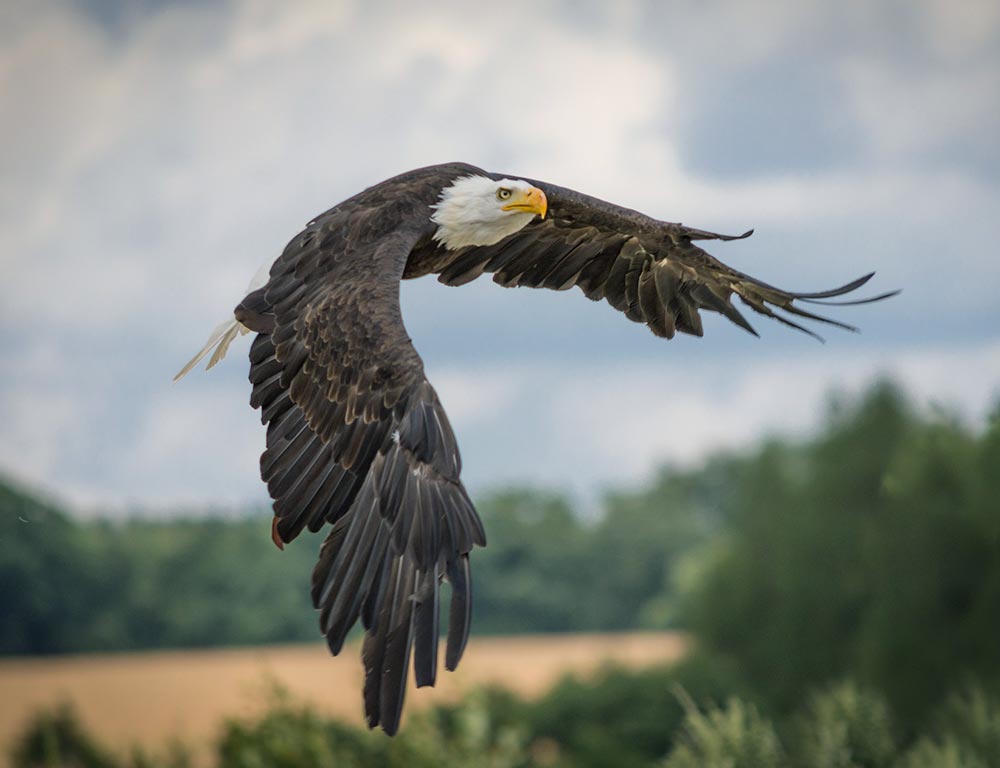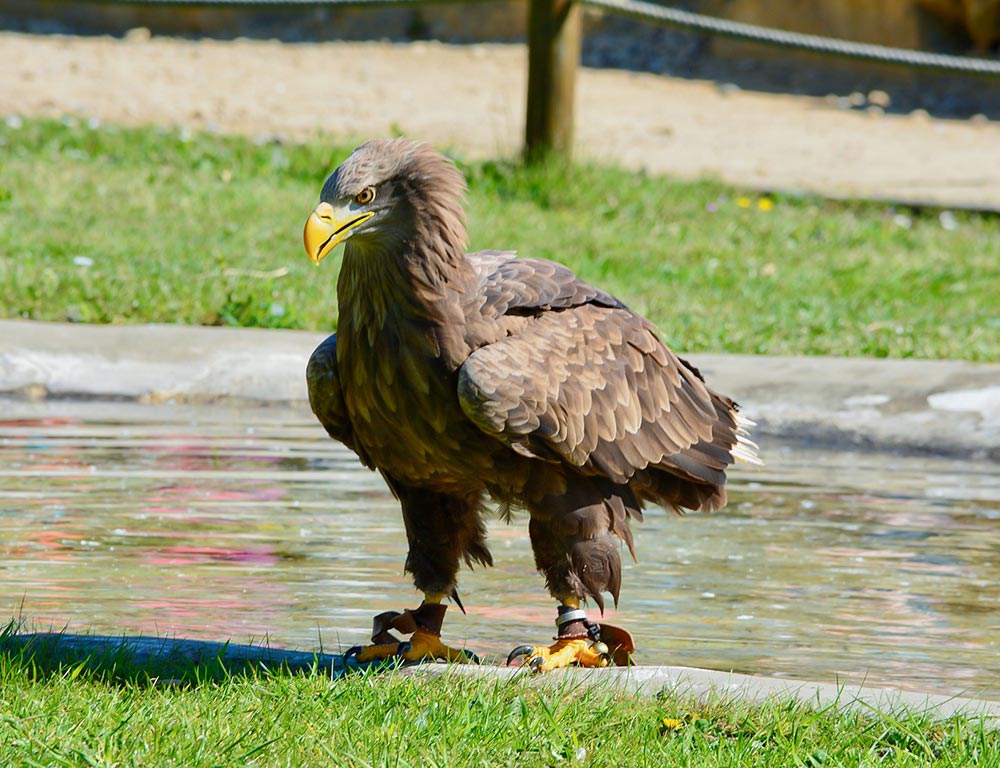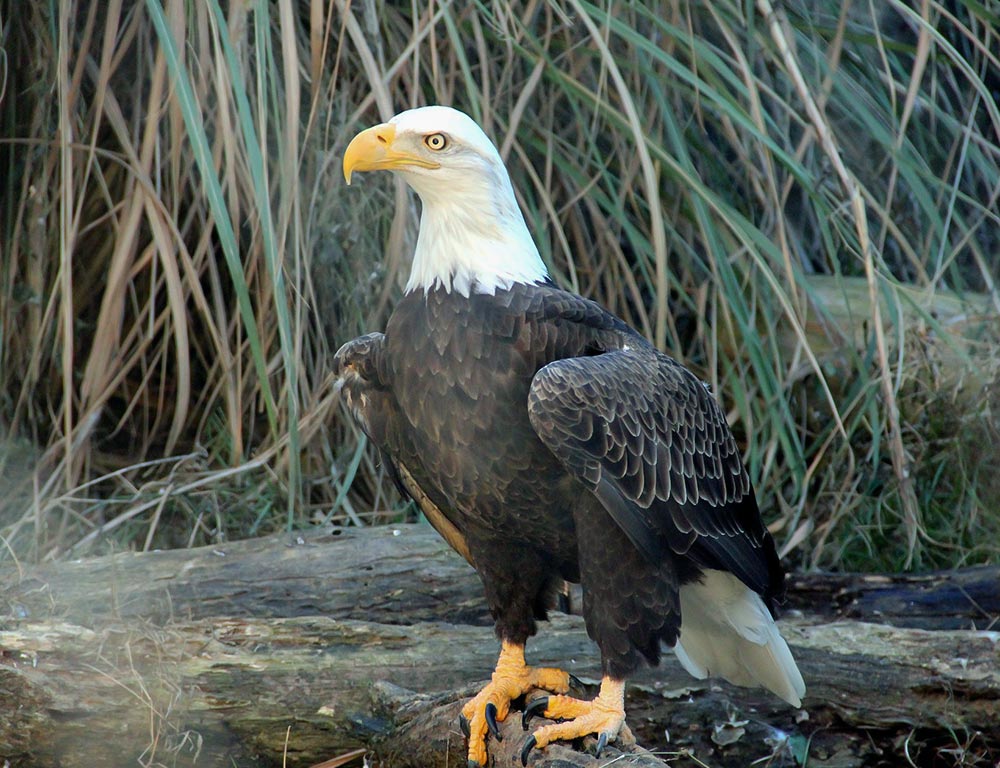Eagles soar through the skies of North Carolina, gracing its diverse landscapes with their majestic presence.
In this exploration of “Eagles in North Carolina,” we delve into the habitats and conservation efforts that play a pivotal role in sustaining these iconic birds of prey.
From the regal Bald Eagle to the elusive Golden Eagle, North Carolina offers a canvas of environments, including lakeshores, rivers, and coastal regions, that serve as vital territories for these majestic raptors.
Join us on a journey through the strategies employed to preserve eagle populations, understanding their behaviors, and the significance of responsible human interaction.
Discover the interconnected efforts that contribute to the preservation of eagles, ensuring that these magnificent creatures continue to thrive in the Tar Heel State.
Is North Carolina A Good Place for Eagles?
North Carolina can be a suitable habitat for eagles, particularly the Bald Eagle (Haliaeetus leucocephalus) and the Golden Eagle (Aquila chrysaetos).
Both species can be found in various parts of the state, especially near large bodies of water such as rivers, lakes, and coastal areas.
Eagles prefer areas with abundant food sources, which often include fish for Bald Eagles and a variety of small mammals for Golden Eagles.
The state’s diverse geography, including mountains, forests, and waterways, provides a range of environments that can support eagle populations.
Conservation efforts, such as habitat protection and banning certain pesticides, have also contributed to the recovery of eagle populations in many areas.
If you are interested in observing eagles in North Carolina, consider visiting wildlife refuges, state parks, or other natural areas with suitable habitats.
Additionally, be mindful of respecting wildlife and their habitats while observing them.
Why There Is Not Many Species of Eagles in North Carolina?

While North Carolina is home to some eagle species, such as the Bald Eagle (Haliaeetus leucocephalus), which is more commonly found, and occasionally the Golden Eagle (Aquila chrysaetos), it’s true that there aren’t as many eagle species compared to some other regions.
There are several reasons for this:
Habitat Availability
Eagles require specific habitats to thrive. Bald Eagles, for example, are often associated with large bodies of water such as lakes, rivers, and coastal areas where they can find fish, a primary food source.
While North Carolina has suitable habitats, not all areas are conducive to supporting large eagle populations.
Food Availability
The availability of prey, especially fish for Bald Eagles and various small mammals for Golden Eagles, plays a crucial role in the distribution of eagle species.
Areas with abundant and easily accessible food resources are more likely to support larger eagle populations.
Human Disturbance
Human activities can impact eagle populations. Urbanization, habitat destruction, and disturbance near nesting sites can negatively affect eagle populations.
Conservation efforts and protected areas are essential for maintaining suitable habitats for these birds.
Migration Patterns
Some eagle species are migratory, and their presence in a particular region may be seasonal.
For example, Golden Eagles are known for their extensive migrations, and while they might pass through North Carolina, they may not be present year-round.
Historical Factors
The historical distribution of eagle populations can also influence their current presence in an area. Factors such as pesticide use, habitat destruction, and persecution have impacted eagle populations in the past.
It’s important to note that while North Carolina might not have a high diversity of eagle species, the presence of even one species, such as the Bald Eagle, indicates that the state provides suitable conditions for at least some eagle populations.
Conservation efforts, habitat protection, and awareness of the needs of these birds can contribute to the well-being of eagle populations in the region.
Types of Eagles in North Carolina
Two prominent eagle species command attention in the skies above North Carolina: the majestic Bald Eagle (Haliaeetus leucocephalus) and the elusive Golden Eagle (Aquila chrysaetos).
These iconic birds of prey contribute to the state’s rich biodiversity, captivating observers with their aerial prowess.
Let’s delve into the intricate details of these eagles, exploring their scientific classification, population dynamics, life span, size, weight, dietary preferences, wingspan, and conservation status.
Bald Eagle (Haliaeetus leucocephalus)

- Scientific Name: Haliaeetus leucocephalus
- Category: Bird of Prey
- Population: In the early 2000s, the Bald Eagle population in North Carolina was around 200 pairs and has shown a significant recovery since conservation efforts were initiated.
- Life Span: Typically 20-30 years in the wild.
- Size: Adult males are slightly smaller, ranging from 28 to 40 inches.
- Weight: Adults weigh 8 to 14 pounds.
- Food: Primarily fish, supplemented by waterfowl, small mammals, and carrion.
- Wingspan: Ranges from 6 to 7 feet.
- Status: The Bald Eagle was removed from the endangered species list in 2007, marking a successful recovery. However, it remains protected under the Bald and Golden Eagle Protection Act.
The Bald Eagle, an emblem of American strength and freedom, exhibits a distinctive white head and tail, contrasting with its dark body.
These birds prefer habitats near large bodies of water, utilizing their powerful talons and keen eyesight to hunt fish. Nests are often constructed in tall trees, where they mate for life and demonstrate remarkable parenting skills.
While their numbers have rebounded, ongoing conservation efforts focus on ensuring a sustainable coexistence with human activities.
Golden Eagle (Aquila chrysaetos)

- Scientific Name: Aquila chrysaetos
- Category: Bird of Prey
- Population: Golden Eagles are less common in North Carolina than the Bald Eagle, and their population varies.
- Life Span: Typically 15-20 years in the wild.
- Size: Larger than Bald Eagles, with a length ranging from 26 to 40 inches.
- Weight: Adults weigh 7 to 14 pounds.
- Food: Mainly prey on mammals like rabbits and ground squirrels, supplemented by birds and carrion.
- Wingspan: Ranges from 6 to 7.5 feet.
- Status: Classified as a species of least concern, but regional populations may face threats from habitat loss and human activities.
Elaboration: The Golden Eagle, recognized by its dark brown plumage and golden neck feathers, is a powerful and skilled predator. In North Carolina, they inhabit mountainous and remote areas.
Known for their impressive soaring flights, Golden Eagles are opportunistic hunters, relying on sharp talons and acute vision to capture prey.
While not as commonly observed as Bald Eagles, their presence underscores the state’s ecological diversity, warranting attention to conservation practices to safeguard their habitats.
Where to Spot Eagles in North Carolina?
Spotting eagles in North Carolina can be a rewarding experience. Here are some places where you might have a good chance of seeing eagles:
Jordan Lake State Recreation Area
Located near Raleigh, Jordan Lake is known for its large population of Bald Eagles. The lake provides an excellent habitat for eagles, especially during winter.
Alligator River National Wildlife Refuge
Situated on the state’s eastern side, this refuge is known for its diverse wildlife, including Bald Eagles. The refuge offers various wildlife viewing opportunities, and guided tours may be available.
Pocosin Lakes National Wildlife Refuge
This refuge in northeastern North Carolina is known for its extensive pocosin wetlands. It provides habitat for both Bald Eagles and Golden Eagles. Keep an eye out for these majestic birds while exploring the refuge.
Great Smoky Mountains National Park
In the western part of the state, the Great Smoky Mountains offer diverse habitats for wildlife. While Bald Eagles are more commonly spotted, the park is known for its rich biodiversity.
Mattamuskeet National Wildlife Refuge
Situated in the coastal plain of eastern North Carolina, Mattamuskeet is one of the largest natural lakes in the state.
It attracts a variety of bird species, including Bald Eagles. The refuge provides opportunities for birdwatching and photography.
Lake Norman
Located near Charlotte, Lake Norman is a large reservoir that can be a good place to spot Bald Eagles. Check out the areas around the lake, especially during the winter when eagles might be more active.
Roanoke River
The Roanoke River and its surrounding wetlands are home to various wildlife, including eagles. Consider exploring areas along the riverbanks or participating in wildlife tours.
When planning a trip to spot eagles, checking with local wildlife agencies, visitor centers, or birdwatching groups for the latest information on eagle sightings and recommended viewing locations is a good idea.
Remember that eagles can be sensitive to human disturbance, so it’s important to observe them from a respectful distance and avoid disturbing their natural behaviors.
How to Preserve Eagles in North Carolina?

Preserving eagles in North Carolina involves a combination of conservation efforts, habitat protection, and responsible human behavior.
Here are some key strategies to help preserve eagles in the state:
Habitat Protection
Support and advocate for protecting eagle habitats, including wetlands, lakes, rivers, and coastal areas.
Encourage establishing and maintaining wildlife refuges and protected areas that provide suitable nesting and feeding grounds for eagles.
Conservation Programs
Support and participate in local and national conservation programs focused on eagles. These programs may include habitat restoration, captive breeding, and monitoring initiatives.
Stay informed about conservation efforts and contribute to organizations working to protect eagles.
Legal Protections
Advocate for and comply with laws and regulations that protect eagles. The Bald and Golden Eagle Protection Act provides legal safeguards for these species in the United States.
Report any incidents of eagle harassment, shooting, or illegal activities to relevant authorities.
Education and Awareness
Increase public awareness about the importance of eagles and their role in ecosystems. Educate communities about the significance of preserving eagle habitats and the potential impacts of human activities on these birds.
Monitoring and Research
Support and participate in research initiatives to understand eagle populations, migration patterns, and behaviors. Report eagle sightings to local wildlife agencies, contributing to monitoring efforts and population assessments.
Responsible Recreation
Practice responsible birdwatching and wildlife photography by maintaining a safe and respectful distance from eagle nests and feeding areas.
Follow guidelines provided by wildlife agencies to minimize disturbance during critical times such as nesting and feeding.
Mitigating Human-Wildlife Conflicts
Collaborate with local communities and authorities to address potential conflicts between eagles and human activities, such as land development and fisheries management.
Implement measures to reduce the impact of human activities on eagle habitats.
Environmental Stewardship
Promote sustainable practices in land use, agriculture, and forestry that consider the needs of eagle habitats. Encourage responsible waste disposal to prevent contamination of water bodies, which can affect eagle prey.
By adopting these strategies, individuals, communities, and organizations can contribute to preserving eagles in North Carolina.
A collaborative and proactive approach is essential to ensure the long-term survival of these magnificent birds.
Wrapping Up
Safeguarding eagles in North Carolina necessitates a multifaceted approach encompassing habitat preservation, conservation initiatives, and responsible human behavior.
By advocating for legal protections, participating in conservation programs, and fostering public awareness, we can ensure the sustained well-being of these iconic birds.
Promoting responsible recreation, supporting research endeavors, and mitigating human-wildlife conflicts are pivotal steps in preserving eagle populations.
Ultimately, environmental stewardship and a commitment to sustainable practices are paramount for securing the future of eagles in North Carolina.
Through collective efforts, we can maintain the delicate balance between human activities and the conservation of these majestic creatures, ensuring their continued presence in the state’s diverse ecosystems.